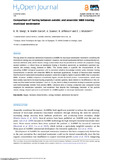JavaScript is disabled for your browser. Some features of this site may not work without it.
| dc.contributor.author | Wang, K. M. | |
| dc.contributor.author | Martin Garcia, N. | |
| dc.contributor.author | Soares, Ana | |
| dc.contributor.author | Jefferson, Bruce | |
| dc.contributor.author | McAdam, Ewan | |
| dc.date.accessioned | 2018-12-17T15:14:48Z | |
| dc.date.available | 2018-12-17T15:14:48Z | |
| dc.date.issued | 2018-11-26 | |
| dc.identifier.citation | KM Wang, N Martin Garcia, A Soares, et al., Comparison of fouling between aerobic and anaerobic MBR treating municipal wastewater. H2Open Journal, 2018, Volume 1, Issue 2, pp. 131-159 | en_UK |
| dc.identifier.issn | 2616-6518 | |
| dc.identifier.uri | https://doi.org/10.2166/h2oj.2018.109 | |
| dc.identifier.uri | http://dspace.lib.cranfield.ac.uk/handle/1826/13746 | |
| dc.description.abstract | The key driver for anaerobic membrane bioreactors (AnMBR) for municipal wastewater treatment is enabling the transition to energy neutral wastewater treatment. However, municipal wastewater delivers a comparatively constrained methane yield, which means energy conservation must be prioritised to achieve the proposed energy neutral ambition. A critical focus on membrane fouling is therefore warranted, as membrane operation represents the primary energy demand in MBRs. This review seeks to quantify the characteristics of the prevailing AnMBR biological suspension and to ascertain whether knowledge transfer exists between fouling characteristics in aerobic and anaerobic MBRs for municipal applications. Analysis of literature data revealed that the level of extractable extracellular polymeric substrate is slightly higher in aerobic MBRs than in anaerobic MBRs. However, AnMBR comprises considerably higher soluble microbial product concentrations, which have been widely reported to increase fouling propensity in aerobic systems. More distinct is the difference in the colloidal and fine solids fraction (between 1 and 10–15 μm), which is likely to dominate fouling in anaerobic systems and limit knowledge transfer from aerobic MBRs. Literature data on energy production was compared to that employed for membrane operation, and evidences that despite the challenging character of the particle matrix, energy neutral operation is achievable for AnMBR applied to municipal wastewater treatment. | en_UK |
| dc.language.iso | en | en_UK |
| dc.publisher | IWA Publishing | en_UK |
| dc.rights | Attribution 4.0 International | * |
| dc.rights.uri | http://creativecommons.org/licenses/by/4.0/ | * |
| dc.subject | biogas | en_UK |
| dc.subject | biomass characteristics | en_UK |
| dc.subject | energy demand | en_UK |
| dc.subject | membrane bioreactor | en_UK |
| dc.title | Comparison of fouling between aerobic and anaerobic MBR treating municipal wastewater | en_UK |
| dc.type | Article | en_UK |
Files in this item
The following license files are associated with this item:
This item appears in the following Collection(s)
-
Staff publications (SWEE) [2825]

